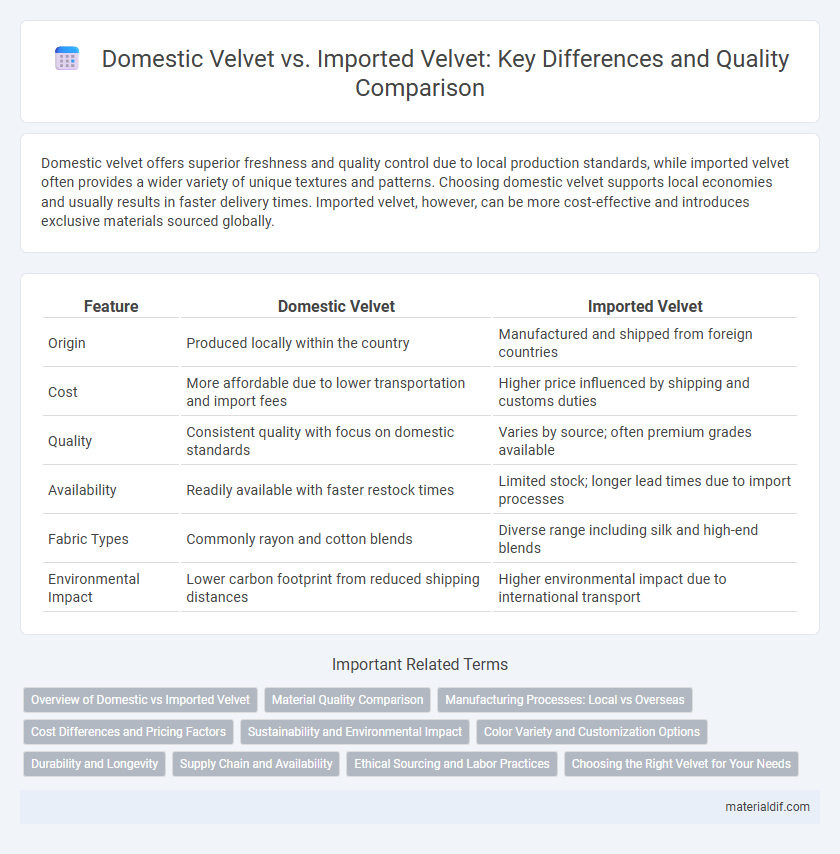Domestic velvet offers superior freshness and quality control due to local production standards, while imported velvet often provides a wider variety of unique textures and patterns. Choosing domestic velvet supports local economies and usually results in faster delivery times. Imported velvet, however, can be more cost-effective and introduces exclusive materials sourced globally.
Table of Comparison
| Feature | Domestic Velvet | Imported Velvet |
|---|---|---|
| Origin | Produced locally within the country | Manufactured and shipped from foreign countries |
| Cost | More affordable due to lower transportation and import fees | Higher price influenced by shipping and customs duties |
| Quality | Consistent quality with focus on domestic standards | Varies by source; often premium grades available |
| Availability | Readily available with faster restock times | Limited stock; longer lead times due to import processes |
| Fabric Types | Commonly rayon and cotton blends | Diverse range including silk and high-end blends |
| Environmental Impact | Lower carbon footprint from reduced shipping distances | Higher environmental impact due to international transport |
Overview of Domestic vs Imported Velvet
Domestic velvet typically offers better control over quality and faster supply chains, ensuring consistent texture and durability for upholstery and fashion applications. Imported velvet may feature a wider variety of unique weaves, dyes, and fibers, reflecting diverse international craftsmanship and often catering to niche market demands. Price differences arise from production costs, tariffs, and shipping, with domestic velvet generally providing cost-effective options while imported varieties prioritize specialized aesthetics and exclusivity.
Material Quality Comparison
Domestic velvet typically features a higher-quality cotton or silk base, resulting in a softer, more durable fabric with better breathability than many imported variants. Imported velvet often utilizes synthetic fibers like polyester, which can compromise the richness of the texture and reduce longevity. The superior material quality of domestic velvet enhances its sheen and resilience, making it a preferred choice for luxury upholstery and fashion applications.
Manufacturing Processes: Local vs Overseas
Domestic velvet manufacturing typically involves smaller-scale production facilities using traditional weaving techniques, ensuring higher control over fabric quality and customization options. Imported velvet often stems from large overseas mills leveraging advanced industrial machinery for mass production, which can result in lower costs but potential variations in texture and durability. Differences in dyeing methods and raw material sourcing also distinguish local velvet from its imported counterparts, impacting overall fabric performance and aesthetic appeal.
Cost Differences and Pricing Factors
Domestic velvet generally offers lower prices compared to imported velvet due to reduced shipping expenses and lower import taxes. Imported velvet often incurs higher costs driven by tariffs, international logistics fees, and exchange rate fluctuations. Pricing factors also include fabric quality variations, with imported velvet sometimes associated with premium craftsmanship that can justify higher price points.
Sustainability and Environmental Impact
Domestic velvet production typically results in a smaller carbon footprint due to reduced transportation emissions and stricter adherence to local environmental regulations. Imported velvet often relies on long-distance shipping, increasing greenhouse gas emissions and potentially involving less sustainable manufacturing practices. Choosing domestic velvet supports local economies and promotes eco-friendly textile production, reducing overall environmental impact.
Color Variety and Customization Options
Domestic velvet offers a limited color palette compared to imported velvet, which provides a broader spectrum of rich and vibrant hues. Imported velvet often features advanced dyeing techniques, resulting in more consistent and customizable color options tailored to specific design needs. Customization options are more extensive with imported velvet, including variations in pile height, fabric weight, and finishes, allowing for greater versatility in interior and fashion applications.
Durability and Longevity
Domestic velvet often exhibits superior durability due to the use of high-quality fibers and tighter weave techniques, enhancing its longevity in everyday use. Imported velvet may vary widely in quality, with some luxury brands offering exceptional resilience while others use delicate materials prone to wear and tear. Choosing domestic velvet ensures consistent strength and prolonged fabric life, making it ideal for frequently used furniture and upholstery.
Supply Chain and Availability
Domestic velvet production offers faster supply chain turnaround and greater control over quality standards compared to imported velvet, which often faces longer lead times due to international shipping and customs delays. Availability of domestic velvet tends to be more consistent, reducing the risk of stockouts and enabling quicker response to market demand fluctuations. Imported velvet, while sometimes offering unique patterns and finishes, is subject to geopolitical risks and transportation disruptions that impact reliability.
Ethical Sourcing and Labor Practices
Domestic velvet often ensures greater transparency in ethical sourcing and labor practices due to stricter regulations and oversight compared to imported velvet, which can sometimes involve less accountable supply chains. Many domestic velvet producers adhere to fair labor standards, sustainable practices, and local sourcing, reducing environmental impact and promoting worker welfare. Imported velvet may vary significantly in ethical compliance depending on the country of origin, with risks of exploitative labor conditions and limited environmental safeguards.
Choosing the Right Velvet for Your Needs
Domestic velvet offers superior quality control and faster availability, making it ideal for projects with tight deadlines or specific customization needs. Imported velvet often provides a wider variety of textures and colors due to global sourcing, suited for designers seeking unique or niche fabrics. Assessing factors like durability, fiber content, price, and intended use helps ensure selecting the right velvet aligns perfectly with your specific functional and aesthetic requirements.
Domestic Velvet vs Imported Velvet Infographic

 materialdif.com
materialdif.com